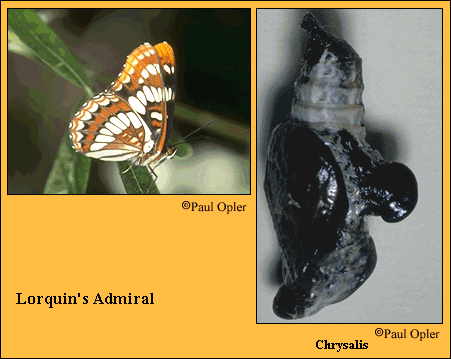 |
 

 |



Lorquin's Admiral (Limenitis lorquini [Boisduval])
Wing span: 2 - 2 5/8 inches (5.1 - 6.7 cm).
Identification: Upperside is black with white median bands on both wings; tip of forewing is orange-brown. Underside is reddish-brown with white markings.
Life history: Males perch in valley bottoms all day to watch for females. Eggs are laid on the upperside of host plant leaf tips. Caterpillars feed on leaves and partially-grown caterpillars overwinter in rolled leaf shelters.
Flight: April-October. Several flights in California, probably one flight in the northern part of its range.
Caterpillar hosts: Wild cherry (Prunus), willows (Salix), poplar and cottonwood (Populus), and orchard trees.
Adult food: Flower nectar from plants including California buckeye, yerba santa, and privet; bird droppings; and dung.
Habitat: Forest edges, mountain canyons, orchards, parks, streamsides, fencerows and groves of cottonwood and poplar.
Range: British Columbia south to southern California and Baja California, east to western Montana and Idaho.
Conservation: Not usually required.
The Nature Conservancy Global Rank: G5 - Demonstrably secure globally, though it may be quite rare in parts of its range, especially at the periphery.
Management needs: None reported.
References:
Scott, J. A. 1986. The butterflies of North America. Stanford University Press,
Stanford, Calif. 583 pages, 64 color plates.
Tilden, J. W. 1986. A field guide to western butterflies. Houghton-Mifflin Co.,
Boston, Mass. 370 pages, 23 color plates.
Author: Jane M. Struttmann

